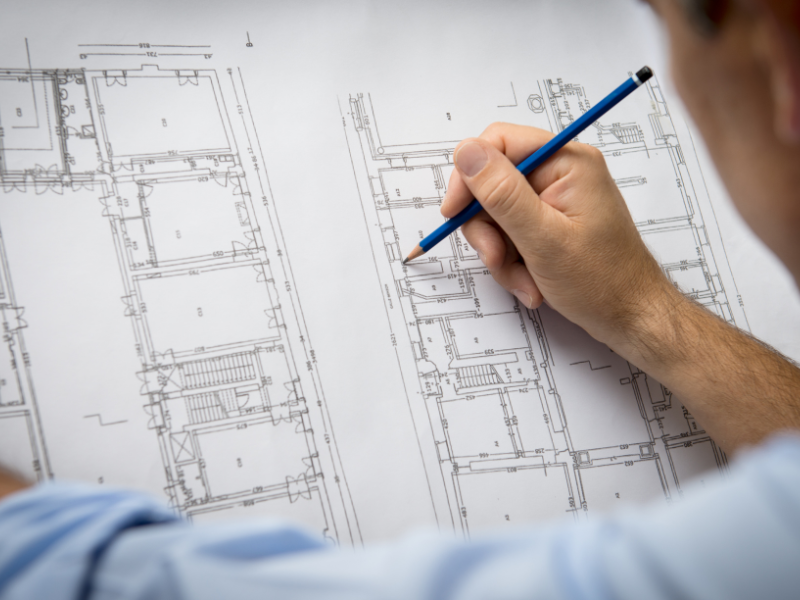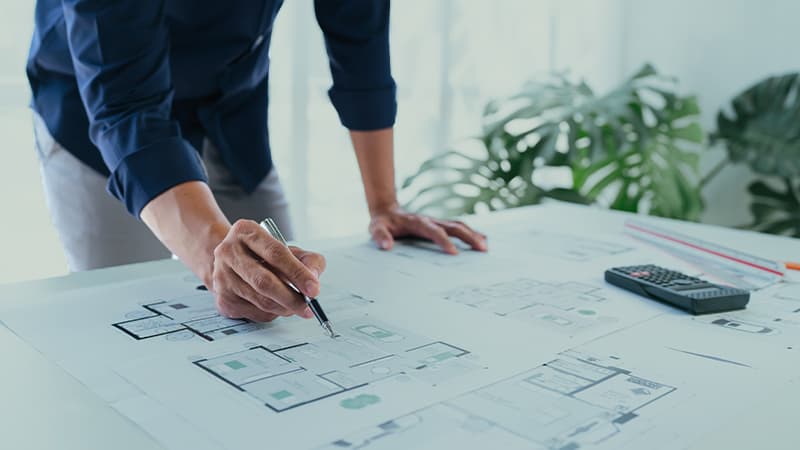Architect Collaboration Tips for Working with Contractors and Builders
Architect Collaboration Tips for Working with Contractors and Builders
Blog Article
Recognizing the Diverse Job Paths Available for Aspiring Architect
As an aspiring Architect, you have a globe of profession courses waiting for you. Each course supplies distinct challenges and opportunities to apply your creative thinking and technical know-how. Whether you're drawn to standard design or the nuances of sustainable layout, there's a particular niche that aligns with your rate of interests. Comprehending these varied options can shape your professional journey, however which instructions will you pick to explore first?
Conventional Design: Creating Structures and Frameworks
Standard design concentrates on making buildings and frameworks that blend capability with aesthetic appeal. As you explore this area, you'll appreciate the intricate balance in between kind and objective. You'll find out to draw ideas from historic designs, incorporating elements like symmetry, materials, and craftsmanship. Your designs can reflect social heritage, showcasing neighborhood practices while fulfilling modern-day demands.
You'll establish skills in drafting, model-making, and website evaluation, enabling you to visualize and communicate your ideas effectively. Involving with customers, you'll require to comprehend their vision and translate it right into viable styles.
In addition, building codes and sustainability practices are necessary in your work, guaranteeing your frameworks are environmentally friendly and safe. As you grow in your profession, you'll discover opportunities in domestic, commercial, and even reconstruction jobs, each offering one-of-a-kind obstacles. Embracing conventional design leads the way for a satisfying profession that pays homage to the past while shaping the future.
Urban Planning: Shaping Areas and Public Spaces
As a hopeful Architect, you can play a crucial function as a city planner, changing exactly how areas interact and operate. By utilizing community engagement approaches, you'll guarantee that homeowners have a voice fit their environment. Plus, incorporating lasting layout concepts will assist produce rooms that not only fulfill today's demands but additionally safeguard the future.
Duty of Urban Planners
While numerous could think about architects as the sole enthusiasts behind structures, city planners play an essential role fit the more comprehensive landscape of areas and public areas. They evaluate land use, zoning legislations, and area needs to develop sustainable settings that enhance lifestyle. By collaborating with various stakeholders, you'll help design parks, transportation systems, and domestic areas that advertise social communication and accessibility. Urban coordinators additionally concentrate on ecological considerations, making certain that advancements integrate environment-friendly rooms and assistance biodiversity. Your proficiency in spatial layout and neighborhood dynamics permits you to envision future development while maintaining social heritage. In this crucial function, you'll straight affect just how people experience their environments, making every job a possibility for favorable adjustment.
Area Involvement Strategies
Effective area involvement approaches are important for metropolitan organizers to assure that the voices of homeowners are heard and valued in the planning procedure. To cultivate meaningful discussion, you should prioritize open online forums and workshops where area participants can reveal their concepts and issues. By proactively listening and including comments, you'll produce areas that mirror the neighborhood's demands, inevitably leading to more lasting and effective city atmospheres.
Lasting Layout Concepts
When creating urban rooms, integrating lasting layout principles is important for developing environments that grow both ecologically and socially. Consider integrating eco-friendly areas, like yards and parks, to enhance biodiversity and boost air top quality.
Creating with water preservation in mind is additionally key-- assume concerning rainfall gardens and permeable surfaces to manage stormwater. Including community members throughout the preparation procedure assurances that the areas you produce fulfill their demands and motivate social communication. By accepting these principles, you'll contribute to vivid, sustainable urban landscapes that profit every person.

Landscape Design: Developing Lasting Outdoor Environments
As you discover landscape architecture, you'll uncover vital style concepts that create attractive and functional outside areas. Lasting methods play an important function in guaranteeing these atmospheres prosper while decreasing environmental effect. Plus, you'll locate a selection of career opportunities that enable you to make a real distinction in how individuals communicate with nature.
Layout Principles in Landscape
Understanding layout principles in landscape style is essential for producing lasting outdoor atmospheres that balance with nature. You'll require to ponder components like range, percentage, and equilibrium to ensure your layouts really feel natural and inviting. Incorporating native plants not only improves biodiversity yet additionally reduces water use, making your landscape durable. Assume concerning the circulation of space and exactly how people communicate with it; pathways and seating areas must welcome exploration and leisure. In addition, focus on seasonal changes, developing with products that complement the surroundings year-round (Architect). By prioritizing sustainability and appearances, you can create exterior spaces that enhance the area and advertise health. Embracing these principles will establish a solid structure for your profession in landscape architecture.
Lasting Practices Review
Sustainable practices in landscape architecture not only focus on looks however also prioritize environmental health and wellness and resource conservation. You can design spaces that promote dirt health, such as exercising and utilizing organic materials permaculture concepts. Inevitably, these practices ensure your designs benefit both people and the setting for years to come.
Profession Opportunities Exploration
With a solid foundation in sustainable techniques, landscape style provides a variety of occupation courses that permit you to make a meaningful influence on the atmosphere. Urban organizers commonly team up with landscape engineers to create environment-friendly areas in urban setups, enhancing city livability. If you're passionate concerning education, take into consideration becoming a landscape style teacher, motivating future generations.
Sustainable Layout: Concentrating On Eco-Friendly Practices
As you explore your job in design, welcoming green practices can establish you apart in an affordable learn this here now area. Sustainable layout focuses on producing buildings that minimize environmental effect while boosting resident wellness. By including sustainable products, energy-efficient systems, and lasting building methods, you'll add to a greener future.
Beginning by gaining understanding of environment-friendly certifications like LEED or BREEAM, which can reinforce your qualifications. Take into consideration how natural light, air flow, and thermal performance can maximize design. Collaborate with engineers and ecological experts to introduce solutions that reduce waste and save sources.
Do not neglect the relevance of community participation-- engaging local stakeholders can inspire styles that balance with the atmosphere. As customers increasingly prioritize sustainability, your know-how in eco-friendly practices will not only draw in tasks however likewise satisfy your interest for accountable architecture. Welcome this critical aspect of the profession, and watch your occupation prosper.
Historical Conservation: Securing and Restoring Cultural Heritage
While you commence on your building trip, think about the vital role of historic conservation in keeping our cultural heritage. This field focuses on the security and remediation of significant structures, websites, and structures that tell the stories of our past. By participating in historical conservation, you'll help safeguard the building heritage that shapes community identification.
As a historic preservation Architect, you'll assess historical significance and evaluate the condition of frameworks. You'll work very closely with historians and preservationists to ensure genuine remediation strategies are utilized. This job path allows you to mix creativity with research study, allowing you to design solutions that respect initial products and workmanship.
Your work not only adds to sustainability by reusing existing structures but likewise cultivates a feeling of satisfaction within neighborhoods. Welcoming this path will assist you come to be a guardian of history, maintaining the stories and aesthetics that enhance our lives.
Inside Style: Enhancing Indoor Spaces
Historical preservation and interior style both share a commitment to improving the developed setting, however they concentrate on various aspects. While historic preservation highlights preserving a framework's historic and social worth, indoor style zeroes in on optimizing indoor areas for performance and visual appeals.
As an ambitious Architect, you'll locate that indoor style permits you to blend creative thinking with technological abilities. You'll make rooms that not just look excellent however likewise advertise comfort and effectiveness. This field includes see here recognizing how light, color, and products connect within a room, influencing mood and functionality.
You'll deal with numerous tasks, from household homes to business workplaces, making sure that each setting fulfills the needs of its occupants. By focusing on individual experience, you can change insides into practical and inspiring spaces, making a significant influence on how individuals interact with their surroundings. Welcome the possibility to improve indoor settings and form the means individuals live and function.
Industrial Layout: Combining Functionality With Appearances
Commercial style plays an important role in developing products that effortlessly blend aesthetic appeals with functionality, making certain that what you utilize daily is not only aesthetically attractive but likewise practical. As an ambitious Architect, you could involve yourself in this area, focusing on developing everything from furnishings to consumer electronic devices. Your work entails recognizing customer requirements, materials, and producing procedures, enabling you to develop innovative services that boost daily experiences.
In commercial style, you'll often team up with marketing professionals, suppliers, and engineers, making sure that your layouts are not only stunning yet likewise possible. You'll find out to stabilize form and feature, focusing on functionality without giving up design. By refining your skills in sketching, 3D modeling, and prototyping, you'll be well-equipped to bring your ideas to life. This occupation course supplies a vibrant environment where creativity satisfies functionality, making it a satisfying option for engineers curious about forming the items of tomorrow.
Often Asked Questions
What Educational Credentials Do I Required to Become an Architect?
To come to be a designer, you'll require an expert degree in design, usually a Bachelor's or Master's. Additionally, you'll need to complete a teaching fellowship and pass the Architect Enrollment Assessment to practice legitimately.
Are There Qualification Demands for Different Building Profession Paths?
Yes, there're qualification demands for numerous architectural courses. Architect. You'll need to pass examinations, full internships, and occasionally go after specialized training, relying on your chosen emphasis, like landscape architecture, metropolitan style, or historical preservation
What Software Program Abilities Are Vital for Architects Today?

Exactly How Can I Gain Practical Experience While Researching Design?
You can gain sensible experience by interning at architectural companies, taking part additional hints in design competitors, volunteering for area projects, or teaming up with classmates on real-world projects. These possibilities improve your abilities and develop beneficial links in the sector.
What Work Opportunities Exist Outside Typical Architecture Firms?
You can discover various job chances outside typical architecture companies, like city planning, indoor layout, landscape design, building and construction management, property growth, and even functions in sustainability consulting. Each deals distinct obstacles and incentives.
Whether you're drawn to conventional style or the subtleties of sustainable style, there's a niche that aligns with your rate of interests.When making urban spaces, integrating lasting layout concepts is important for developing settings that grow both ecologically and socially.As you check out landscape design, you'll find crucial layout concepts that develop gorgeous and useful outdoor spaces.Understanding design principles in landscape architecture is vital for producing lasting outside settings that integrate with nature.In commercial style, you'll usually team up with makers, designers, and marketing experts, guaranteeing that your designs are not only attractive but additionally possible.
Report this page